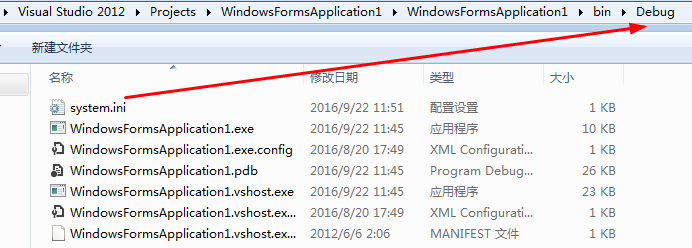读配置文件与写配置文件的核心代码如下:
1 [DllImport("kernel32")] 2 // 读配置文件方法的6个参数:所在的分区(section)、键值、 初始缺省值、 StringBuilder、 参数长度上限、配置文件路径 3 private static extern int GetPrivateProfileString(string section, string key, string deVal, StringBuilder retVal, 4 int size, string filePath); 5 6 [DllImport("kernel32")] 7 // 写配置文件方法的4个参数:所在的分区(section)、 键值、 参数值、 配置文件路径 8 private static extern long WritePrivateProfileString(string section, string key, string val, string filePath); 9 10 public static void SetValue(string section, string key, string value) 11 { 12 //获得当前路径,当前是在Debug路径下 13 string strPath = Environment.CurrentDirectory + "\system.ini"; 14 WritePrivateProfileString(section, key, value, strPath); 15 } 16 17 public static string GetValue(string section, string key) 18 { 19 StringBuilder sb = new StringBuilder(255); 20 string strPath = Environment.CurrentDirectory + "\system.ini"; 21 //最好初始缺省值设置为非空,因为如果配置文件不存在,取不到值,程序也不会报错 22 GetPrivateProfileString(section, key, "配置文件不存在,未取到参数", sb, 255, strPath); 23 return sb.ToString(); 24 25 } 26 27 28
【应用举例】
功能说明:程序加载时,创建配置文件并往里面写入波特率参数。(配置文件不需要事先存在,此Windows的API会自动创建)。点击button1,将取到的波特率显示到textBox1中。
完整代码如下:
1 using System; 2 using System.CodeDom; 3 using System.Collections.Generic; 4 using System.ComponentModel; 5 using System.Data; 6 using System.Drawing; 7 using System.IO; 8 using System.Linq; 9 using System.Runtime.InteropServices; 10 using System.Text; 11 using System.Threading.Tasks; 12 using System.Windows.Forms; 13 14 namespace WindowsFormsApplication1 15 { 16 public partial class Form1 : Form 17 { 18 public Form1() 19 { 20 InitializeComponent(); 21 } 22 23 24 [DllImport("kernel32")] 25 // 读配置文件方法的6个参数:所在的分区(section)、键值、 初始缺省值、 StringBuilder、 参数长度上限、配置文件路径 26 private static extern int GetPrivateProfileString(string section, string key, string deVal, StringBuilder retVal, 27 int size, string filePath); 28 29 [DllImport("kernel32")] 30 // 写配置文件方法的4个参数:所在的分区(section)、 键值、 参数值、 配置文件路径 31 private static extern long WritePrivateProfileString(string section, string key, string val, string filePath); 32 33 public static void SetValue(string section, string key, string value) 34 { 35 //获得当前路径,当前是在Debug路径下 36 string strPath = Environment.CurrentDirectory + "\system.ini"; 37 WritePrivateProfileString(section, key, value, strPath); 38 } 39 40 public static string GetValue(string section, string key) 41 { 42 StringBuilder sb = new StringBuilder(255); 43 string strPath = Environment.CurrentDirectory + "\system.ini"; 44 //最好初始缺省值设置为非空,因为如果配置文件不存在,取不到值,程序也不会报错 45 GetPrivateProfileString(section, key, "配置文件不存在,未取到参数", sb, 255, strPath); 46 return sb.ToString(); 47 48 } 49 50 private void Form1_Load(object sender, EventArgs e) 51 { 52 SetValue("参数","波特率","9600"); 53 } 54 55 private void button1_Click(object sender, EventArgs e) 56 { 57 textBox1.Text = GetValue("参数", "波特率"); 58 } 59 60 61 62 } 63 }
程序界面:


